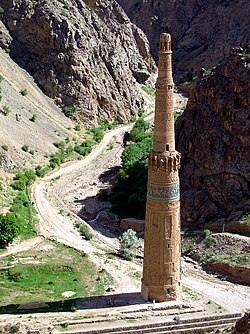| Minaret of Jam | |
|---|---|
 | |
| Type | Minaret |
| Location | Shahrak District, Ghor Province, Afghanistan |
| Coordinates | 34°23′47.6″N 64°30′57.8″E / 34.396556°N 64.516056°E |
| Height | 65 m (213 ft) |
| Built | c. 1190 |
| Official name | Minaret and Archaeological Remains of Jam |
| Type | Cultural |
| Criteria | (ii), (iii), (iv) |
| Designated | 2002 (26th session) |
| Reference no. | 211 |
| Region | Central Asia |
| Endangered | 2002–... |
The Minaret of Jam (Pashto and Dari: منار جام) is a UNESCO World Heritage Site in western Afghanistan. It is located in a remote and nearly inaccessible region of the Shahrak District, Ghor Province, next to the Hari River. The 62 m (203 ft)[1] or 65 m (213 ft)[2] high minaret was built c. 1190 entirely of baked bricks and is famous for its intricate brick, stucco and glazed tile decoration, which consists of alternating bands of kufic and naskhi calligraphy, geometric patterns, and verses from the Qur'an. Since 2002, the minaret has remained on the list of World Heritage in Danger, under serious threat of erosion, and has not been actively preserved.[3] In 2014, the BBC reported that the tower was in imminent danger of collapse.[4]
In 2020, the Minaret of Jam was listed among cultural heritage sites of the Islamic world by the Islamic World Educational, Scientific and Cultural Organization (ICESCO). According to the Afghan Ministry of Foreign Affairs (MoFA), the Minaret of Jam is Afghanistan's first cultural heritage site to be listed by ICESCO.[5]
- ^ Ghaznavid and Ghūrid Minarets, Ralph Pinder-Wilson, Iran, Vol. 39, (2001), 167.
- ^ "Afghan historic minaret of Jam 'in danger of collapse'". BBC. BBC News. Archived from the original on 28 September 2018. Retrieved 23 July 2018.
- ^ "- YouTube". www.youtube.com. Archived from the original on 2022-07-26. Retrieved 2022-11-18.
- ^ "Afghan historic minaret of Jam 'in danger of collapse'". BBC News. 2014-08-28. Archived from the original on 2018-07-19. Retrieved 2022-11-18.
- ^ "Minaret of Jam Listed as ICESOCO Heritage Site". TOLOnews. Archived from the original on 2021-01-20. Retrieved 2021-01-17.
